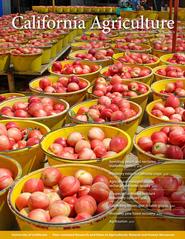All Issues

At R&D Farms in Reedley, Calif., nectarines and peaches are picked in buckets to protect fruit during handling just before transfer to the packing line for cleaning, sanitation, sorting, sizing and packing. Photo by Carlos H. Crisosto.
Volume 74, Number 3
News and opinion
An interview with UC Cooperative Extension experts about the effect of the coronavirus pandemic on food systems, youth development and nutrition.
Recent articles from the Agricultural Experiment Station campuses and UC ANR's county offices, institutes and research and extension centers.
Surveys show that agritourism operators in California need increased support from their local governments and the state regarding regulatory requirements.





